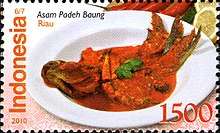Asam pedas
Asam pedas (Indonesian and Malay: Asam Pedas, Minangkabau: Asam Padeh, English: Sour and Spicy) is a Minangkabau and Malay sour and spicy fish stew dish.[2] It is from Indonesia and is popular in Malaysia.
 Asam padeh, a Padang style asam pedas | |
| Course | Main course |
|---|---|
| Place of origin | Indonesia[1] |
| Region or state | Sumatra, Malay Peninsula |
| Serving temperature | Hot or room temperature |
| Main ingredients | Fish cooked in sour and hot sauce |
Region

The spicy and sour fish dish is known widely in Sumatra and Malay Peninsula. It is part of the culinary heritage of both Minangkabau and also Malay traditions, thus its exact origin is unclear. The Minang asam padeh can be easily found throughout Padang restaurants in Indonesia and Malaysia.[2]
It has become a typical cuisine of Malays from eastern shoes of Sumatra - Jambi, Riau, Riau Islands, and as far north in Aceh and across the Straits of Malacca in Johore, Malacca and Singapore. The spice mixture and the fish used might be slightly different according to the area.
Preparation
The main ingredients in asam pedas are usually seafood or freshwater fish. They are cooked in asam (tamarind) fruit juice with chilli and spices.
The cooking process involves soaking the pulp of the tamarind fruit until it is soft and then squeezing out the juice for cooking the fish. Asam paste may be substituted for convenience. Vegetables such as terong or brinjals (Indian eggplants), okra and tomatoes are added.
Fish and seafood — such as mackerel, mackerel tuna, tuna, skipjack tuna, red snapper, gourami, pangasius, hemibagrus or cuttlefish — either the whole body or sometimes only the fish heads are added to make a spicy and tart fish stew. It is important that the fish remain intact for serving so generally the fish is added last.[3]
In Indonesia, the most common fish used in asam pedas is tongkol (mackerel tuna).
Kaeng som is the Thai version of asam pedas.[4] In Bengal, India there is a similar dish is called Macher tak (sour fish).
See also
References
| Wikimedia Commons has media related to Asam pedas. |
- "Asam pedas, Makanan populer nusantara yang berasal dari masyarakat minangkabau, "Asam pedas"".(Indonesian)
- Donny Syofyan (24 November 2013). "By the way ... I just can't live without Padang food". The Jakarta Post.
- "Asam Pedas". Tastefood. Archived from the original on 2012-01-03.
- "Kaeng-som, a Thai culinary classic".